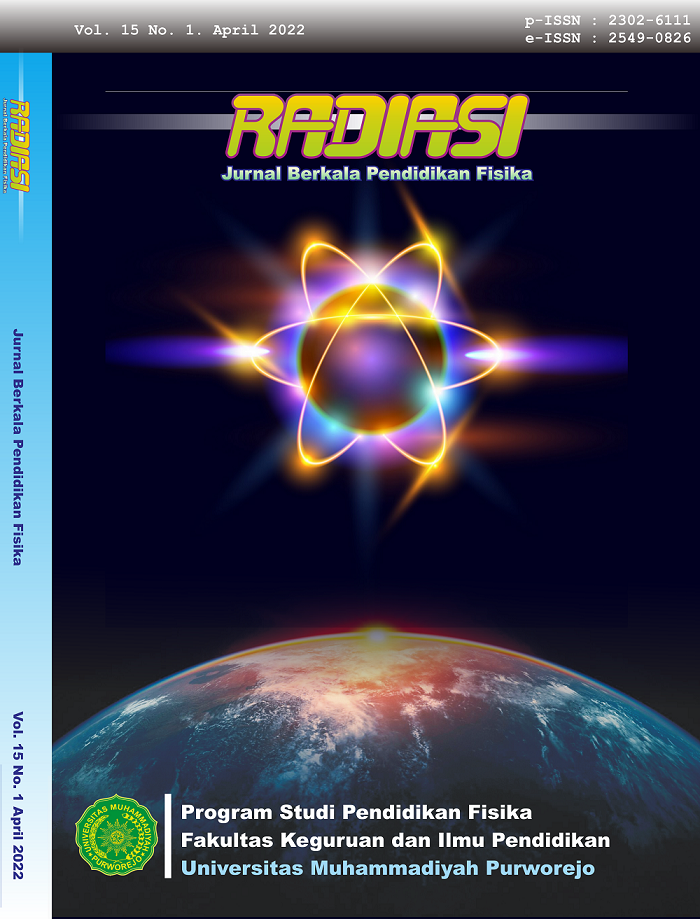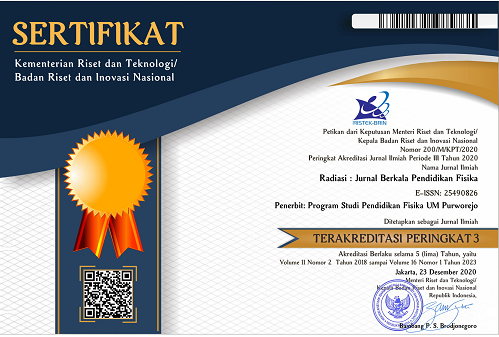The Influence of Online Learning on Physics Learning Outcomes During The Covid-19 Pandemic
Abstract
Throughout the COVID-19 pandemic, it is hoped that all elements of education can still facilitate learning so that children remain active even though they are online. The Indonesian policy of the government in dealing with the spread of the COVID-19 outbreak is to prevent it by imposing social distancing. This policy impacts all lives, Education is one of them., especially in the online learning process. Physics is one of the specialization subjects given to high school students. The purpose of this research is to determine impact of online learning Physics on student learning outcomes and the things that affect this impact. This type of research is a mixed-method—qualitative data obtained by observation, documentation, and interview techniques. Quantitative data comes from evaluating student achievement before the application of online learning (before the pandemic) and after the implementation of online learning (during the pandemic). Participants in this quantitative study were 116 students, and qualitative participants were 5 students' parents. The result of this study is that there is a significant impact or difference between the effects of learning Physics before and after the pandemic. This can be seen from the effects of Pillai's trace, Wilks lambda, Hoteling's trace, and Roy's most enormous root test results stating that the significance value at 0.000 is smaller than 0.05. It can also be seen from the average before the pandemic, 80,04 and after the pandemic, 82.11 This is caused by that there is excessive parental participation in completing each student's task at home.
Downloads
References
Y. C. Wu, C. S. Chen, and Y. J. Chan, “An summary of the COVID-19 epidemic,” Journal of the Chinese Medical Association, vol. 83, no. 3. pp. 217–220, 2020, doi: 10.1097/JCMA.0000000000000270.
Z. Miftah and I. P. Sari, “analysis of online learning systems using the sus method,” Res. Dev. J. Educ., vol. 1, no. 1, p. 40, 2020, doi: 10.30998/rdje.v1i1.7076.
E. Chung, G. Subramaniam, and L. C. Dass, “In the midst of Covid-19, university students in Malaysia are prepared to engage in online learning.,” Asian J. Univ. Educ., vol. 16, no. 2, pp. 45–58, 2020, doi: 10.24191/AJUE.V16I2.10294.
M. Lutfi, P. C. D. Buntuang, Y. Kornelius, Erdiyansyah, and B. Hasanuddin, “The influence of Indonesian small and medium-sized firms on social distancing policy (SMEs).,” Probl. Perspect. Manag., vol. 18, no. 3, pp. 492–503, 2020, doi: 10.21511/ppm.18(3).2020.40.
D. Aldila et al., “A mathematical analysis of the transmission of COVID-19 in Jakarta, Indonesia, taking social distance and fast assessment into consideration.,” Chaos, Solitons and Fractals, vol. 139, 2020, doi: 10.1016/j.chaos.2020.110042.
L. D. Herliandry, N. Nurhasanah, M. E. Suban, and H. Kuswanto, “Lessons Learned During the Covid-19 Pandemic,” JTP - J. Teknol. Pendidik., vol. 22, no. 1, pp. 65–70, 2020, doi: 10.21009/jtp.v22i1.15286.
J. W. Kusuma and H. Hamidah, “comparison of mathematics learning outcomes with the use of the whatsapp group and webinar zoom platforms in distance learning during the covid 19 pandemic,” JIPMat, vol. 5, no. 1, 2020, doi: 10.26877/jipmat.v5i1.5942.
S. Hadi, D. Andrian, and B. Kartowagiran, “In Indonesia, a methodology for assessing vocational skills programs based on local content curriculum has been established..,” Eurasian J. Educ. Res., vol. 2019, no. 82, pp. 45–62, 2019, doi: 10.14689/ejer.2019.82.3.
F. Gunawan, Ni Made Yeni Suranti, “During the COVID-19 Pandemic, Different Models and Learning Platforms Were Used for Prospective Teachers,” vol. 1, no. 2, pp. 75–94, 2020.
Nurhayati, L. Yuliati, and N. Mufti, “Physics Synthesis Problem Solving,,” Juranal Pendidik. Teor. Penelitian, dan Pengemb., vol. 1 Nomor 8, pp. 1594–1597, 2016.
S. Hamdi, B. Kartowagiran, and Haryanto, “Creating a testlet model for elementary school mathematics,” Int. J. Instr., vol. 11, no. 3, pp. 375–390, 2018, doi: 10.12973/iji.2018.11326a.
J. Siswanto, “The Effectiveness of STEM-Based Physics Education in Increasing Student Creativity,” J. Penelit. Pembelajaran Fis., vol. 9, no. 2, pp. 133–137, 2018, doi: 10.26877/jp2f.v9i2.3183.
M. Sa’diah, E. Mujahidin, and R. Hartono, “In the middle of the Covid-19 epidemic, the role of government in utilizing information technology to create innovation in student learning at Ibn Khaldun University,” Asian ESP J., vol. 16, no. 51, pp. 74–92, 2020.
J. L. Martín Ayala, S. Castaño Castaño, A. Hernández Santana, M. Martí González, and J. Brito Ballester, “The effect of learning in the twenty-first century on the academic outcomes of undergraduate psychology students,” Sustain., vol. 13, no. 16, pp. 1–17, 2021, doi: 10.3390/su13168735.
J. Gore, L. Fray, A. Miller, J. Harris, and W. Taggart, The effect of COVID-19 on student learning in primary schools in New South Wales: an empirical study, vol. 48, no. 4. 2021.
R. Khalil et al., “A qualitative study of medical students' opinions on the rapid change to synchronized online learning in Saudi Arabia during the COVID-19 epidemic.,” BMC Med. Educ., vol. 20, no. 1, pp. 1–10, 2020, doi: 10.1186/s12909-020-02208-z.
Y. Khurriyati, F. Setiawan, and L. Binti Mirnawati, “The impact of online learning on student learning outcomes,” Pendidik. Dasar, vol. VIII, no. 1, pp. 91–104, 2021.
J. . Creswell, “Qualitative, quantitative, and mixed methods approaches,” in Research design, London: Sage Publication Inc, 2013, pp. 1–26.
A. Onwuegbuzie and N. Leech, “Using Mixed Methods to Answer Research Questions Procedures for Data Analysis 1,” Qual. Rep., 2015, doi: 10.46743/2160-3715/2006.1663.
J. DiPasquale and W. Hunter, “Critical Thinking in Asynchronous Online Discussions: A Systematic Examination” Can. J. Learn. Technol. / La Rev. Can. l’apprentissage la Technol., vol. 44, no. 2, 2018, doi: 10.21432/cjlt27782.
M. B. Miles and A. M. Huberman, Qualitative Data Analysis Source Book About New Methods (Translation). 2007.
D. Elliott, S. Husbands, F. C. Hamdy, L. Holmberg, and J. L. Donovan, “Qualitative Research Methods for Understanding and Improving Recruitment to Randomized Controlled Trials,” European Urology, vol. 72, no. 5. pp. 789–798, 2017, doi: 10.1016/j.eururo.2017.04.036.
C. Willig and M. Borcsa, “Conclusion: Reflections on Research Questions, Methods, and Knowledge in Mental Health Qualitative Research,” in Qualitative Research Methods in Mental Health, 2021, pp. 251–261.
K. Dewi and I. Anisykurlillah, “The Effect of Fraud Pentagon Factors on Fraudulent Financial Statements, with the Audit Committee as a Moderating Variable,” Account. Anal. J., vol. 10, no. 1, pp. 39–46, 2021, doi: 10.15294/aaj.v10i1.44520.
A. A. P. Antara and B. Bastari, “Vertical Equalization With Classical Approach And Item Response Theory For Elementary School Students,” J. Penelit. dan Eval. Pendidik., vol. 19, no. 1, pp. 13–24, 2015, doi: 10.21831/pep.v19i1.4551.
J. F. Hair Jr, R. E. Anderson, B. J. Babin, and W. C. Black, multivariate-data-analysis-7th-edition.pdf, 7th ed. Pearson Prentice Hall, 2015.
Copyright (c) 2022 Suhariyono Suhariyono, Heri Retnawati

This work is licensed under a Creative Commons Attribution-NonCommercial 4.0 International License.




